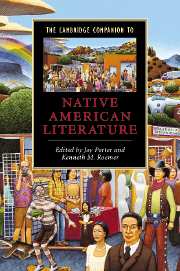Book contents
- Frontmatter
- Introduction
- Timeline
- Part I Historical and cultural contexts
- Part II Genre contexts
- Part III Individual authors
- 10 N. Scott Momaday
- 11 Simon Ortiz
- 12 James Welch
- 13 Leslie Marmon Silko
- 14 Gerald Vizenor
- 15 Louise Erdrich’s storied universe
- 16 Joy Harjo’s poetry
- 17 Sherman Alexie
- Bio-bibliographies
- Further reading
- Index
- Series List
13 - Leslie Marmon Silko
storyteller
from Part III - Individual authors
Published online by Cambridge University Press: 28 May 2006
- Frontmatter
- Introduction
- Timeline
- Part I Historical and cultural contexts
- Part II Genre contexts
- Part III Individual authors
- 10 N. Scott Momaday
- 11 Simon Ortiz
- 12 James Welch
- 13 Leslie Marmon Silko
- 14 Gerald Vizenor
- 15 Louise Erdrich’s storied universe
- 16 Joy Harjo’s poetry
- 17 Sherman Alexie
- Bio-bibliographies
- Further reading
- Index
- Series List
Summary
Novelist, poet, essayist, photographer, cinematographer, and in every case storyteller: Leslie Marmon Silko is perhaps the most familiar and most often anthologized American Indian writer today, and her novel Ceremony is as widely recognized as any other contemporary American novel. In Ceremony as in all her other work to date, Silko's creative vision has been shaped in nearly equal measure by the land and by the variety of oral and written storytelling performances that were a part of her life growing up at Laguna Pueblo. According to both cultural anthropology and oral tradition, Laguna has always been one of the most adaptive pueblo communities in the Southwest, and many of the stories comprising Laguna oral tradition preserve the complex strategies of resistance and assimilation that have enabled the people to survive and adjust to myriad external pressures. Like her native Laguna, Silko's work is a study in cultural mediation and spirit transformation. Again and again her creative vision celebrates the transformative power of story and place, working together for life in a healing way.
Backgrounds
Leslie Marmon Silko was born in Albuquerque, New Mexico on 5 March 1948. Her mother, Virginia Leslie, was originally from Montana; her father, Lee Howard Marmon, was at the time just out of the Army, beginning his career as a professional photographer and managing the Marmon Trading Post in the village of Old Laguna, about fifty miles west of Albuquerque. Along with her two younger sisters, Wendy and Gigi, Leslie was raised in one of the houses on the southeast edge of Old Laguna village, the part of the village closest to the Rio San Jose´ and, just beyond the river, US Route 66, now Interstate 40.
- Type
- Chapter
- Information
- The Cambridge Companion to Native American Literature , pp. 245 - 256Publisher: Cambridge University PressPrint publication year: 2005
- 1
- Cited by



